|
|
|
Sort Order |
|
|
|
Items / Page
|
|
|
|
|
|
|
| Srl | Item |
| 1 |
ID:
170680
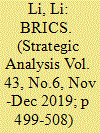

|
|
|
|
|
| Summary/Abstract |
The emergence of BRICS is a reflection of the economic power shift from the north to the south. BRICS cooperation is driven by their shared identity as emerging economies. BRICS will play a bigger role in reshaping the world economic order through reform of the existing international institutions and within the framework of G20. It is in no way aimed at toppling the existing world order or forming an anti-West bloc. The strength of BRICS depends on continued domestic reforms within its member states, its institutionalization, and its cooperation with others both from the south and the north
|
|
|
|
|
|
|
|
|
|
|
|
|
|
|
|
| 2 |
ID:
059930
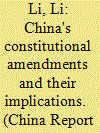

|
|
|
|
|
| Publication |
Jan-Mar 2005.
|
|
|
|
|
|
|
|
|
|
|
|
|
|
|
|
| 3 |
ID:
148535
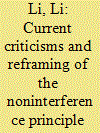

|
|
|
|
|
| Summary/Abstract |
The “Five Principles of Peaceful Coexistence” was born against the background of poverty, powerlessness and humiliation. It became the guiding principle of China`s foreign policy since it was first proposed in 1953. However, several reasons led to increasing criticisms of it, especially regarding the noninterference principle. These reasons include the economic interdependence and blurring of boundaries in a globalized world, the rise of China`s power, and China`s extending overseas interests. The criticisms are reflected in three aspects: whether sovereignty allows for humanitarian intervention against the background of proliferating international human rights norms; whether China`s behavior obeys the noninterference principle; and whether this principle can serve China`s national interests. Chinese scholars respond to these criticisms in terms of three aspects: the noninterference principle should be flexibly interpreted depending on the specific background; many alternate terms of the principle like “creative involvement,” “constructive intervention,” and “participatory advocacy” were put forward; China`s sticking to the fundamental sovereignty principle has never changed. It is sensible and necessary for China to reframe the noninterference principle based on analysis from international, regional and domestic levels. This reframing should protect China`s national interests while matching the image of “responsible great power.”
|
|
|
|
|
|
|
|
|
|
|
|
|
|
|
|
| 4 |
ID:
187917
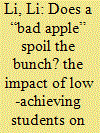

|
|
|
|
|
| Summary/Abstract |
This paper investigates whether the presence of low-achieving classmates affects the noncognitive outcomes of regular students in junior high school. Exploiting random assignments of teachers and students to classes, we show that having classmates who had ever repeated a grade in primary school improves students' mental health and social skills, and the positive peer effects are concentrated among students with a longer duration of peer exposure and students from low socioeconomic backgrounds. Mechanism analysis reveals that the improved teacher–student and student–student interactions contribute to the enhancement of noncognitive outcomes.
|
|
|
|
|
|
|
|
|
|
|
|
|
|
|
|
| 5 |
ID:
098210
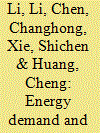

|
|
|
|
|
| Publication |
2010.
|
| Summary/Abstract |
In this paper, Shanghai's CO2 emissions from 1995 to 2006 were estimated following the IPCC guidelines. The energy demand and CO2 emissions were also projected until 2020, and the CO2 mitigation potential of the planned government policies and measures that are not yet implemented but will be enacted or adopted by the end of 2020 in Shanghai were estimated. The results show that Shanghai's total CO2 emissions in 2006 were 184 million tons of CO2. During 1995-2006, the annual growth rate of CO2 emissions in Shanghai was 6.22%. Under a business-as-usual (BAU) scenario, total energy demand in Shanghai will rise to 300 million tons of coal equivalent in 2020, which is 3.91 times that of 2005. Total CO2 emissions in 2010 and 2020 will reach 290 and 630 million tons, respectively, under the BAU scenario. Under a basic-policy (BP) scenario, total energy demand in Shanghai will be 160 million tons of coal equivalent in 2020, which is 2.06 times that of 2005. Total CO2 emissions in 2010 and 2020 in Shanghai will be 210 and 330 million tons, respectively, 28% and 48% lower than those of the business-as-usual scenario. The results show that the currently planned energy conservation policies for the future, represented by the basic-policy scenario, have a large CO2 mitigation potential for Shanghai.
|
|
|
|
|
|
|
|
|
|
|
|
|
|
|
|
| 6 |
ID:
098540
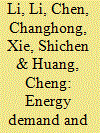

|
|
|
|
|
| Publication |
2010.
|
| Summary/Abstract |
In this paper, Shanghai's CO2 emissions from 1995 to 2006 were estimated following the IPCC guidelines. The energy demand and CO2 emissions were also projected until 2020, and the CO2 mitigation potential of the planned government policies and measures that are not yet implemented but will be enacted or adopted by the end of 2020 in Shanghai were estimated. The results show that Shanghai's total CO2 emissions in 2006 were 184 million tons of CO2. During 1995-2006, the annual growth rate of CO2 emissions in Shanghai was 6.22%. Under a business-as-usual (BAU) scenario, total energy demand in Shanghai will rise to 300 million tons of coal equivalent in 2020, which is 3.91 times that of 2005. Total CO2 emissions in 2010 and 2020 will reach 290 and 630 million tons, respectively, under the BAU scenario. Under a basic-policy (BP) scenario, total energy demand in Shanghai will be 160 million tons of coal equivalent in 2020, which is 2.06 times that of 2005. Total CO2 emissions in 2010 and 2020 in Shanghai will be 210 and 330 million tons, respectively, 28% and 48% lower than those of the business-as-usual scenario. The results show that the currently planned energy conservation policies for the future, represented by the basic-policy scenario, have a large CO2 mitigation potential for Shanghai.
|
|
|
|
|
|
|
|
|
|
|
|
|
|
|
|
| 7 |
ID:
167921
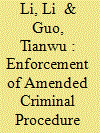

|
|
|
|
|
| Summary/Abstract |
In a move towards a more liberal criminal justice system, the Chinese criminal procedure law (CPL) was amended in 2012 to redistribute the power between state agents and private participants. However, the enforcement of this law is still influenced by the power imbalance between the public and private participants. This article argues that strong authorities together with weak social participation have led to the emergence of several trends in the enforcement of the amended CPL. This article concludes by reflecting on the unbalanced relationships between public and private participants, and reveals the underlying causes.
|
|
|
|
|
|
|
|
|
|
|
|
|
|
|
|
| 8 |
ID:
169793
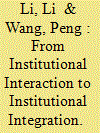

|
|
|
|
|
| Summary/Abstract |
How does the establishment of the National Supervisory Commission affect China's capacity to curb corruption? Using published materials and fieldwork data, this article addresses this question by comparing the newly established anti-corruption agency with the previous dual-track system. It first examines the previous system by focusing on four dimensions of the interaction between the Commission for Discipline Inspection (CDI) and the People's Procuratorate: complementarity, convergence, competition and conflict. Although the CDI and the procuratorate compensated for each other's deficiencies, competition and conflicts between the two institutions were rife, reducing the efficiency of China's anti-corruption work. The article then investigates what impact the establishment of the National Supervisory Commission has had on China's capacity to combat corruption. This new model strengthens the Party's capacity to curb corruption, and the focus of the anti-corruption work has shifted from punishment to prevention, but the Party still needs to resolve three types of unbalanced power relations: between supervision, prosecution and trial; between central and local authorities; and between the state and citizens.
|
|
|
|
|
|
|
|
|
|
|
|
|
|
|
|
| 9 |
ID:
161175
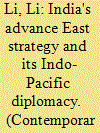

|
|
|
| 10 |
ID:
158783
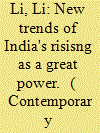

|
|
|
| 11 |
ID:
022002
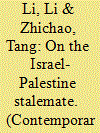

|
|
|
|
|
| Publication |
July 2002.
|
| Description |
23-38
|
|
|
|
|
|
|
|
|
|
|
|
|
|
|
|
| 12 |
ID:
086536
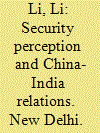

|
|
|
|
|
| Publication |
New Delhi, K W Publishers, 2009.
|
| Description |
ix, 181p.
|
| Standard Number |
97881879662
|
|
|
|
|
|
|
|
|
|
|
|
Copies: C:1/I:0,R:0,Q:0
Circulation
| Accession# | Call# | Current Location | Status | Policy | Location |
| 054120 | 327.20954051/LI, 054120 | Main | On Shelf | General | |
|
|
|
|
| 13 |
ID:
189322
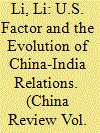

|
|
|
|
|
| Summary/Abstract |
China-India relations are at a crossroads. Since May 2020, the two neighbors have been locked in a protracted border standoff. The format of bilateral engagement based on the delinking of the boundary dispute from cooperation in other areas is under challenge. This article argues that the U.S. factor has been playing a significant role in the evolution of China-India relations since 1988. The U.S. factor impacts China's perception of India and India's policy toward China. Prior to the U.S. strategic shift to great-power competition, China viewed India as a partner and focused on engagement with India. Designating China as a major competitor, India used the U.S. factor as leverage in its relations with China. However, India was suspicious of the cooperative side of the Sino-U.S. relations and chose to hedge between China and the U.S. Since the U.S. has identified China as a strategic competitor and introduced the Indo-Pacific strategy, India has significantly tilted toward the U.S. and embraced the Quad. As the U.S. Indo-Pacific strategy leaves China facing two-front challenges, China's security concerns about India have largely increased. The asymmetry of mutual security perceptions of China and India is decreasing. Since India's China policy is moving from hedging to balancing and China is introducing balancing into its India policy despite commitment to engagement, the two Asian powers might be trapped in a mutual balancing in an era of great-power competition.
|
|
|
|
|
|
|
|
|
|
|
|
|
|
|
|
|
|
|
|
|